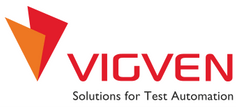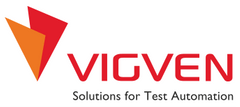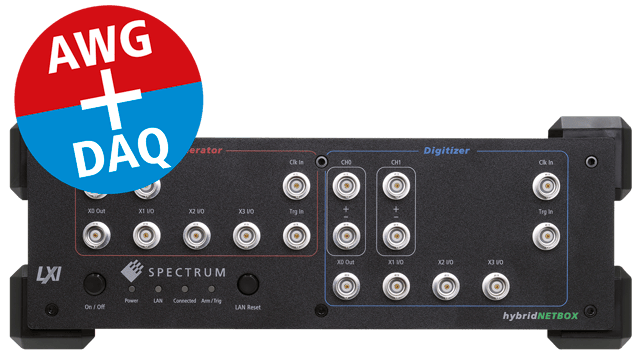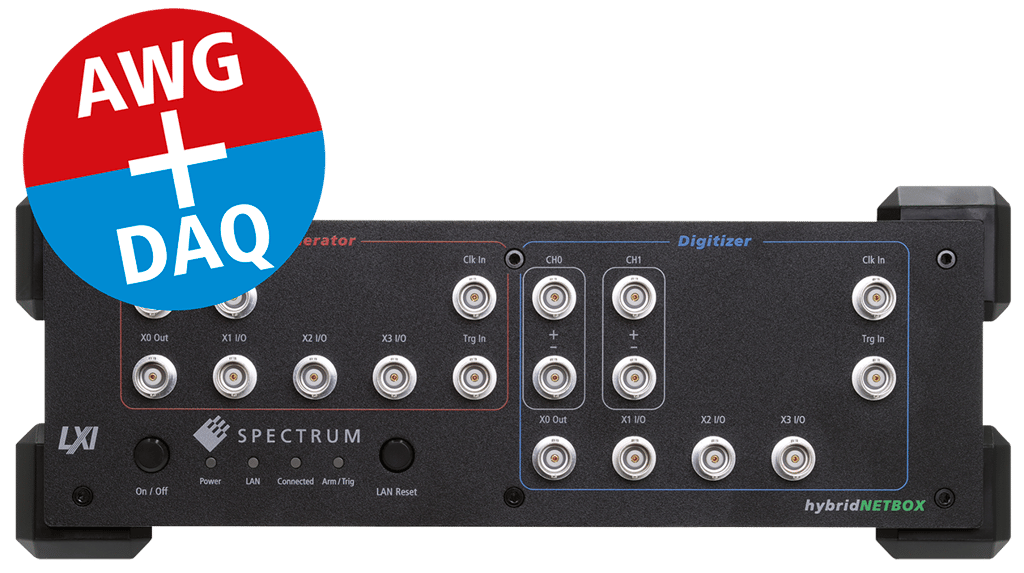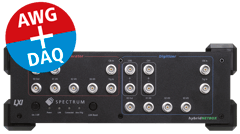16 bit digitizer and AWG
The hybridNETBOX DN2.80/81x series internally consists of a Digitizer and an AWG that can run together or independently. That allows simultaneous data generation and data acquisition for stimulus-response tests, ATE applications, MIMO applications or closed-loop applications. Used independently, the digitizer can acquire test data in the field and the AWG can replay this test data in lab. The hybridNETBOX offers 16 bit resolution and is available with sampling rates of 40 MS/s and 125 MS/s. The hybridNETBOX can be installed anywhere in the company LAN and can be remotely controlled from a host PC.
The digitizerNETBOX and generatorNETBOX offer a powerful GBit Ethernet connection and are fully LXI compatible. The netbox can be used as tabletop instrument or 19" rack mount operation. It can be connected anywhere in your LAN or directly point-to-point with your Laptop/Workstation. A full option package and software package including SBench 6 Professional is included. The first data acquisition can be done within minutes: connect power + ethernet + signals, swicth on, install software on client PC, detect the digitizerNETBOX/generatorNETBOX with Discovery, start SBench 6, do the first acquisition!
Application Examples
- Stimulus-Response
- Recorder/Replay
- Automated Test
- Component Test
- MIMO
Modes
Triggers
The data acquisition boards offer a wide variety of trigger modes. Besides the standard signal checking for level and edge as known from oscilloscopes it's also possible to define a window trigger. Trigger conditions can be combined with logical conjunctions like OR to adopt to different application scenarios.
All boards can be triggered using a separate external trigger signal with a two level programmable window comparator and a second separate external trigger with a single programmable level comparator. It's possible to use positive or negative edge. An internally recognized trigger event can - when activated by software - be routed to a multi purpose i/o connector to start external instruments.
The Gated Sampling option allows data recording controlled by an external gate signal. Data is only recorded if the gate signal has a programmed level. In addition a pre-area before start of the gate signal as well as a post area after end of the gate signal can be acquired. The number of gate segments is only limited by the used memory and is unlimited when using FIFO mode.
The Multiple Recording option allows the recording of several trigger events with an extremely short re-arming time. The hardware doesn't need to be restarted in between. The on-board memory is divided in several segments of the same size. Each of them is filled with data if a trigger event occurs. Pre- and posttrigger of the segments can be programmed. The number of acquired segments is only limited by the used memory and is unlimited when using FIFO mode.
Defines the minimum or maximum width that a trigger pulse must have to generate a trigger event. Pulse width can be combined with channel trigger, pattern trigger and external trigger. This makes it possible to trigger on signal errors like too long or too short pulses.
The trigger event is a slope inside the signal that is larger (or even smaller) than a programmed slope. Internally the difference of two adjacent samples is calculated and then compared to the programmed trigger level. This trigger mode allows the detection of signal distortions as needed for power line monitoring.
The timestamp option writes the time positions of the trigger events in an extra memory. The timestamps are relative to the start of recording, a defined zero time, externally synchronized to a radio clock, or a GPS receiver. With this option acquisitions of systems on different locations can be set in a precise time relation.
